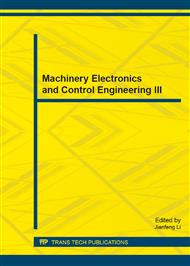p.44
p.48
p.53
p.58
p.62
p.66
p.70
p.76
p.80
Experiment on Yield Strength of PZT-4 Piezoelectric Generating Column
Abstract:
PZT-4 as a piezoelectric material has been studied extensively. When the piezoelectric ceramic is loaded with a pressure which exceeds certain strength, it becomes plastic deformation. In the condition of the pressure disappearing, the piezoelectric ceramic which still has residual strain can not return to the initial state, which will lead to the destruction of the piezoelectric generator. It is necessary to obtain the yield strength in studying the generating performance of the piezoelectric material. The paper designed a kind of measurement methods in stress-strain experiment for the PZT-4 piezoelectric generating column of highway piezoelectric generators. The measurement of the stress-strain mechanical characteristic curve of the PZT-4 piezoelectric generating column was shown in this work. It finally finds the inflection points of elastic deformation and plastic deformation of PZT-4 piezoelectric generating column and the yield strength of PZT-4, in order to provide yield strength parameter for the design of highway piezoelectric generators.
Info:
Periodical:
Pages:
62-65
Citation:
Online since:
December 2013
Authors:
Price:
Сopyright:
© 2014 Trans Tech Publications Ltd. All Rights Reserved
Share:
Citation:


